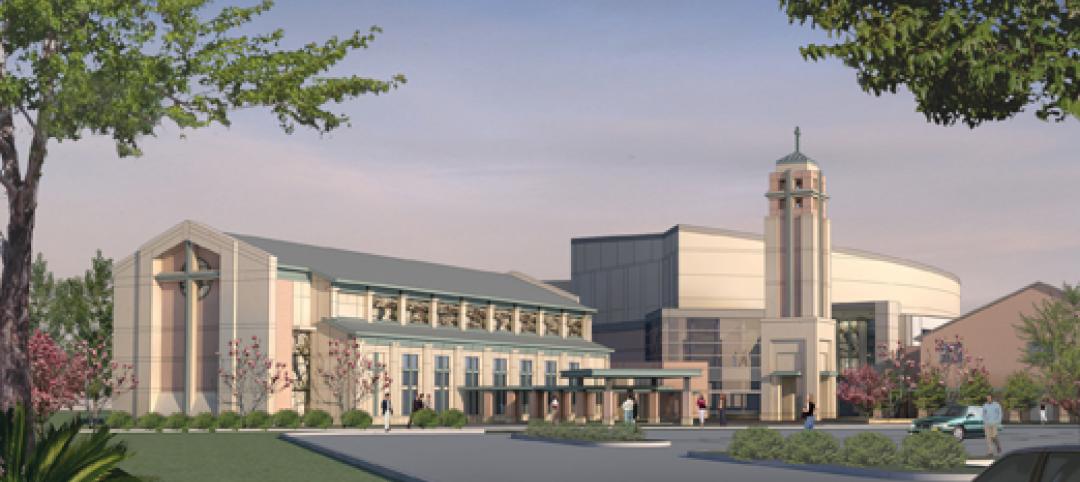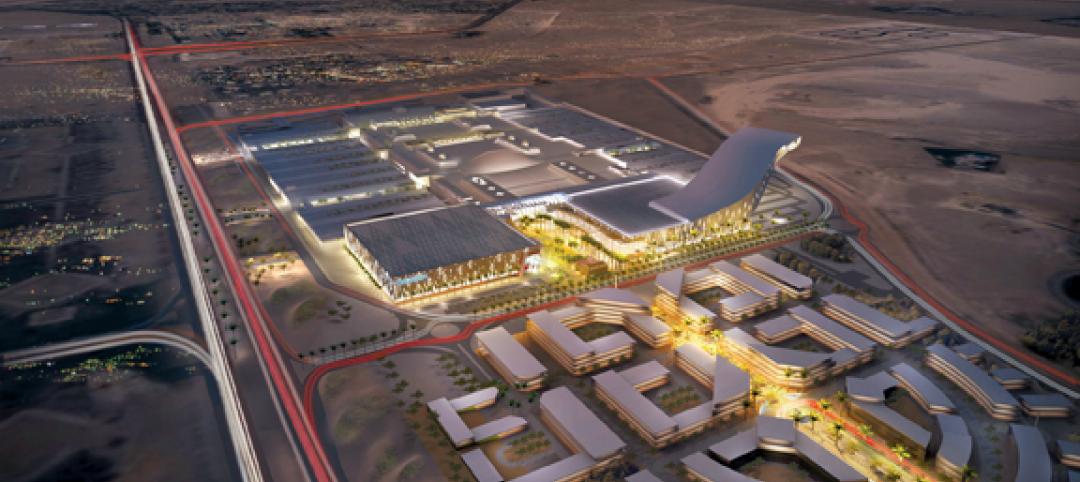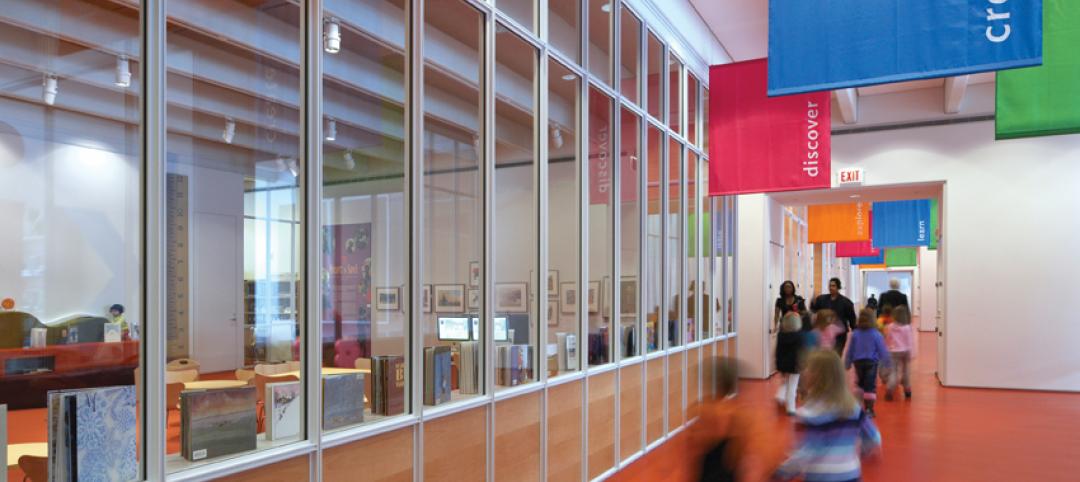When Kaiser Permanente opens its massive, one-million-sf Oakland Medical Center Replacement Project early next year, staff, patients, and families may notice something peculiar about the place. Open almost any door in the complex and they’ll find a stamp-size, red-and-white emblem affixed to the hinge side of the doorjamb. A closer look will reveal the logo of McCarthy Building Companies at the center of the label.
No, this isn’t a sly branding scheme by the project’s general contractor. It’s a quick response (QR) code created for that specific location in the building—for use by both the Building Team during construction and Kaiser Permanente’s facilities team throughout the life of the buildings.
The QR codes are a vital component of one the largest implementations to date of augmented reality (AR) technology in the U.S. construction industry. At any given time, a project superintendent, subcontractor, architect, facilities team member, or other field personnel can scan one of the QR codes throughout the campus with a smartphone or tablet computer and instantly immerse themselves in the up-to-date, as-built 3D BIM model or 3D laser scan of that space.
Augmented reality: 12 applications for design and construction professionals
Building Design+Construction reached out to AEC professionals who have studied and applied augmented reality and asked them to pinpoint applications that are ripe for the technology. Here’s what they had to offer. Read article.
Want to see what’s behind a wall? Simply scan the QR code on the doorjamb in the room, point the mobile device’s camera lens toward the wall, and voilà!, you have an x-ray view of the wall assembly. From that point in the model, you can navigate to other spaces in the facility while maintaining the AR session. You could, for instance, compare the behind-wall infrastructure of the room you’re in to that of the adjacent room. The QR codes serve as a marker to help team members quickly place themselves at a specific point in the model or 3D laser scan.
“The intent was to keep it as simple and easy as possible for the end users in field,” says Chris Pechacek, McCarthy’s Virtual Design and Construction Director (www.mccarthy.com). “They don’t have to be software gurus and know how navigate through the model, or start their AR session on the outside of the building and have to make their way into the building. It enables all users to instantly access the information they need, saving precious time and avoiding frustrations with traditional systems.”
The QR codes also provide the team with one-click access to important project documentation, including RFIs, change orders, warranties, 2D plans, submittals, equipment manuals, and markups. To deliver this information to the field, McCarthy’s IT team built a custom digital document dashboard, which connects all relevant project information using a 2D interface. The setup incorporates a collection of software apps, including Bluebeam Vu, BIMAnywhere, BIM 360 Glue, and Faro Webshare, to allow a range of document types to be quickly accessed and viewed on tablets and smart phones in the field.
To help field personnel quickly access 3D BIM models and other project documents for the Oakland Medical Center Replacement Project, general contractor McCarthy Building Companies placed hundreds of QR codes throughout the complex. Users simply scan one of the QR codes with a smartphone or tablet computer and instantly immerse themselves in the up-to-date, as-built 3D BIM model or 3D laser scan of that space. Photo: McCarthy Building Companies
Pechacek says there are huge advantages to implementing AR on the job site, especially for complex, legacy buildings like hospitals. Take change orders, for example. In long-running hospital construction projects, where technologies and processes may change multiple times during a three- to five-year project span, change orders can have a significant impact on the project schedule and budget.
“Say the client wants to change out a piece of equipment in a patient room,” says Pechacek. “Traditionally, the subs would have to open up the entire wall, clean it out, locate the hookups for the equipment, wait for inspection approval, and close and patch up the wall—a process that can take more than a day.”
Using AR, the team would be able to cut that timeframe down to hours, says Pechacek. “The laser scanning shows exact, as-built information, so you know precisely where the wall backing, pipes, boxes for the connections, med gas, etc., are located behind the wall or above the ceiling,” he says. “So instead of opening the entire wall, they can hole saw to the exact location of the pipe, connect it, and do a quick patch in about an hour.”
The same goes for operations and maintenance applications. Not having to take a patient room out of commission to perform maintenance, repairs, or upgrades offers substantial savings for the healthcare system client. Also, all major building systems will have their own QR code, for instant access to manuals, warranties, preventive maintenance schedules, and work histories.
“For them to be able to walk into a room with a tablet and see exactly where everything is or access information on a piece of equipment without having to run back to their computer, that’s a huge benefit,” says Pechacek.
The key to McCarthy’s AR implementation is capturing the as-built environment at several stages during construction using 3D laser scanning. The McCarthy team conducted comprehensive scanning sessions during the final-inspection stage, when all building systems and infrastructure were installed and the team was waiting for final signoff to close up the walls and ceilings.
“Most AEC firms will laser scan existing conditions for use for design development on a renovation project,” he says. “We’re doing it during the course of construction, creating as-builts as we go, and using that as a component within our change-management process. This has allowed us to mitigate the impacts of changes, and has helped to keep us on schedule and within budget. For such a large project, it’s a substantial feat to be able to pull this off.”
Eventually, several hundred QR codes will be placed throughout the complex, on the doorjambs of most rooms, as well as on key building and medical equipment and systems.
AR comes to the AEC sector
Since the mid-1960s, computer scientists and inventors have tested the concept of overlaying digital information onto the real world, first with bulky, head-mounted displays and later with sleek, portable monitors. But it wasn’t until Apple popularized the iPad in early 2010 that AR would become financially feasible for general construction applications. With the meteoric rise of tablet computing came the boom in tablet apps—the combination of which provided AEC professionals with a relatively low-cost, consumer-level hardware/software solution for bringing AR to the field. Almost overnight, any design or construction professional with $500 and basic knowledge of AR had a method for bringing his or her 3D models to life on the job site.
Today, there are nearly a dozen AR-related apps available on iTunes or Google Play, and more are in the works, according to Dace Campbell, AIA, LEED AP, Customer Success Manager with Autodesk, who has been developing, applying, and promoting AR in the AEC industry for years (Campbell authored an article on the topic for BD+C in February 2012).
“Products like Google Glass have made augmented reality more of a household term,” says Campbell, who was named a BD+C “40 Under 40” honoree in 2011. While real-world AR applications are still rare in the construction industry, Campbell sees the adoption rate growing as the next generation of tools is developed and AEC professionals become more familiar with the technology.
Campbell says the next iteration of AR software apps will offer better integration with existing BIM workflows, allowing field users to access, review, and update the model in real time.
“The current state of apps requires you to divorce away from your standard tools, do a one-off exploration with consumer-level AR tools, and then you’re left with a branch in the workflow that’s a dead end,” says Campbell. “If you don’t have software that works with your everyday tools, AR becomes an expensive, specialized case. AR shouldn’t be a standalone app. Soon, the best BIM apps will likely have an AR mode.”
Another obstacle is the sheer amount of data in models. Many consumer-level AR apps and tablet computers have a difficult time handling rich data sets, especially for large projects like stadiums and hospitals. Some teams have had to simplify their data sets in order to implement AR, which goes back to the BIM-workflow disconnect problem.
Campbell also sees accuracy problems related to AR hardware and software. “AR is all about the co-location of virtual and physical space, or virtual data onto physical space, no matter what the display device is,” he says. “Through that you have to co-locate that data correctly in the space, which comes down to position tracking, orientation tracking, and scale. AEC models are built full-scale, and orientation tracking is relatively easy, especially with a tablet’s gyroscope. Position tracking is the real challenge—there’s no consumer-level, out-of-the box solution for accurate position tracking today. We have GPS, which works with line-of-sight applications outdoors, but that’s only accurate to the nearest meter.”
Finally, in the not-too-distant future, teams won’t have to use QR codes or markers on the job site, because the AR application will recognize precisely where the mobile device is located on the site and will automatically orient and match the model view.
“That’s the Holy Grail, and I think we’re getting there,” says Campbell. “In the meantime we have to work with markers to get reasonably accurate tracking.
“A number of software companies have been hard at work to come up with the next generation of tools that address the problems that people have encountered,” he says. “I’m optimistic that we’re less than 18 months away from some big developments.”
Related Stories
| Feb 11, 2011
Iowa surgery center addresses both inpatient and outpatient care
The 12,000-person community of Carroll, Iowa, has a new $28 million surgery center to provide both inpatient and outpatient care. Minneapolis-based healthcare design firm Horty Elving headed up the four-story, 120,000-sf project for St. Anthony’s Regional Hospital. The center’s layout is based on a circular process flow, and includes four 800-sf operating rooms with poured rubber floors to reduce leg fatigue for surgeons and support staff, two substerile rooms between each pair of operating rooms, and two endoscopy rooms adjacent to the outpatient prep and recovery rooms. Recovery rooms are clustered in groups of four. The large family lounge (left) has expansive windows with views of the countryside, and television monitors that display coded information on patient status so loved ones can follow a patient’s progress.
| Feb 11, 2011
Grocery store anchors shopping center in Miami arts/entertainment district
18Biscayne is a 57,200-sf urban retail center being developed in downtown Miami by commercial real estate firm Stiles. Construction on the three-story center is being fast-tracked for completion in early 2012. The project is anchored by a 49,200-sf Publix market with bakery, pharmacy, and café with outdoor seating. An additional 8,000 sf of retail space will front Biscayne Boulevard. The complex is in close proximity to the Adrienne Arsht Center for the Performing Arts, the downtown Miami entertainment district, and the Omni neighborhood, one of the city’s fast-growing residential areas.
| Feb 11, 2011
Chicago architecture firm planning one of China’s tallest towers
Chicago-based Goettsch Partners was commissioned by developer Guangzhou R&F Properties Co. Ltd. to design a new 294,570-sm mixed-use tower in Tianjin, China. The Tianjin R&F Guangdong Tower will be located within the city’s newly planned business district, and at 439 meters it will be one of China’s tallest buildings. The massive complex will feature 134,900 sm of Class A office space, a 400-key, five-star hotel, 55 condominiums, and 8,550 sm of retail space. The architects are designing the tower with multi-story atriums and a high-performance curtain wall to bring daylight deep into the building, thereby creating deeper lease spans. The project is currently finishing design.
| Feb 11, 2011
Two projects seek to reinvigorate Los Angeles County medical center
HMC Architects designed two new buildings for the Los Angeles County Martin Luther King, Jr., Medical Center as part of a $360 million plan to reinvigorate the campus. The buildings include a 120-bed hospital, which involves renovation of an existing tower and several support buildings, and the construction of a new multi-service ambulatory care center. The new facilities will have large expanses of glass at all waiting and public areas for unobstructed views of downtown Los Angeles. A curved glass entrance canopy will unite the two buildings. When both projects are completed—the hospital in 2012 and the ambulatory care center in 2013—the campus will have added more than 460,000 sf of space. The hospital will seek LEED certification, while the ambulatory care center is targeting LEED Silver.
| Feb 11, 2011
Sustainable community center to serve Angelinos in need
Harbor Interfaith Services, a nonprofit serving the homeless and working poor in the Harbor Area and South Bay communities of Los Angeles, engaged Withee Malcolm Architects to design a new 15,000-sf family resource center. The architects, who are working pro bono for the initial phase, created a family-centered design that consolidates all programs into a single building. The new three-story space will house a resource center, food pantry, nursery and pre-school, and administrative offices, plus indoor and outdoor play spaces and underground parking. The building’s scale and setbacks will help it blend with its residential neighbors, while its low-flow fixtures, low-VOC and recycled materials, and energy-efficient mechanical equipment and appliances will help it earn LEED certification.
| Feb 11, 2011
Texas megachurch inspired by yesteryear’s materials, today’s design vocabulary
The third phase of The First Baptist Church of Pasadena, Texas, involves construction of a new 115,000-sf worship center addition. Currently in design by Zeigler Cooper, the project will include a 2,500-seat worship center (with circular layout and space for a 50-person orchestra and 200-person choir), a 500-seat chapel (for weddings, funerals, and special events), and a prayer room. The addition will connect to the existing church and create a Christian Commons for education, administration, music, and fellowship. The church asked for a modern design that uses traditional materials, such as stone, brick, and stained glass. Construction is scheduled to begin this summer.
| Feb 11, 2011
Apartment complex caters to University of Minnesota students
Twin Cities firm Elness Swenson Graham Architects designed the new Stadium Village Flats, in the University of Minnesota’s East Bank Campus, with students in mind. The $30 million, six-story residential/retail complex will include 120 furnished apartments with fitness rooms and lounges on each floor. More than 5,000 sf of first-floor retail space and two levels of below-ground parking will complete the complex. Opus AE Group Inc., based in Minneapolis, will provide structural engineering services.
| Feb 11, 2011
Four-story library at Salem State will hold half a million—get this—books!
Salem State University in Massachusetts broke ground on a new library and learning center in December. The new four-story library will include instructional labs, group study rooms, and a testing center. The modern, 124,000-sf design by Boston-based Shepley Bulfinch includes space for 500,000 books and study space for up to a thousand students. Sustainable features include geothermal heating and cooling, rainwater harvesting, and low-flow plumbing fixtures.
| Feb 11, 2011
Green design, white snow at Egyptian desert retail complex
The Mall of Egypt will be a 135,000-sm retail and entertainment complex in Cairo’s modern 6th of October district. The two-story center is divided into three themed zones—The City, which is arranged as a series of streets lined with retail and public spaces; The Desert Valley, which contains upscale department stores, international retailers, and a central courtyard for music and other cultural events; and The Crystal, which will include leisure and entertainment venues, including a cinema and indoor snow park. RTKL is designing the massive complex to LEED Silver standards.
| Feb 10, 2011
7 Things to Know About Impact Glazing and Fire-rated Glass
Back-to-basics answers to seven common questions about impact glazing and fire-rated glass.


















